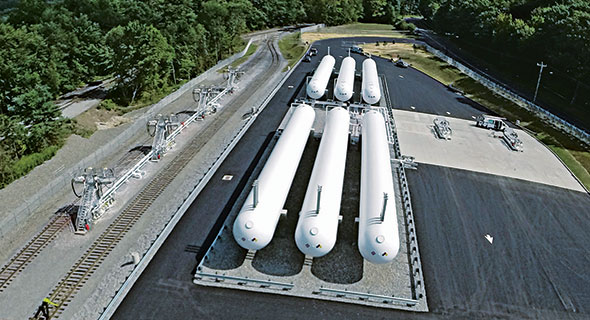In the Know: Propane inventory

Better rail facilities smooth out propane distribution processes. Photo courtesy of Inland Fuel Terminals
In the Know is a monthly partnership between LP Gas magazine and Propane Resources. Our focus this month is on propane inventory, addressed by Pat Thornton, supply and risk management expert for Propane Resources.
Q: According to the U.S. Energy Information Administration, U.S. propane inventory reached 104 million barrels entering the heating season – a 4 percent increase from the same time last year. What factors specific to the current heating season will impact that total through March 2017?
A: Many factors, including exports, weather and propane production levels, will impact the total U.S. propane inventory between now and March 2017.
For years, it was considered comfortable for U.S. propane inventory to total 60 million barrels going into October. With the U.S. shale revolution that has ramped up production of natural gas and propane, it is more common to have closer to 100 million barrels at the beginning of October. But it is also becoming more common to deplete propane barrels at a faster rate thanks to increased export capacity.
The U.S. capacity to dramatically produce more propane has caused the U.S. capacity to export more propane to ramp up, as well. Enterprise Products Partners saw the shale boom as an opportunity to meet increasing demand for propane and butane in faraway locations. Petrochemical plants in Asia were developing a strong appetite for propane and butane almost 10 years ago, just as excess propane and butane were being produced.
At the time, the capacity to ship propane was only 4 million barrels per month. Today, the capacity to ship propane exceeds 30 million barrels per month.
During the summer, the record appeared to be 900,000 barrels per day (bpd). Exports have dwindled since then, reaching as low as 424,000 bpd in September.
More recently, we have seen a resurgence of exports to a new level of 981,000 bpd. This reminds us the combination of cold weather in the U.S., cold weather abroad and high demand for propane at home and abroad in the petrochemical industry can quickly deplete inventory. Some suggest we could easily export 30 to 33 million barrels per month in the December-to-February time frame.
U.S. Energy Information Administration (EIA) data for last year had propane at 99.1 million barrels going into October and showed a depletion of 33.8 million barrels by the end of March 2016. This year, after entering winter at 104 million barrels, EIA projects a depletion of 40.6 million barrels by March 2017.
While we have not experienced a significant crop drying year, EIA notes the potential for increased exports to deplete inventory faster this year. EIA notes that, in comparison to five-year averages, storage is up in the Gulf Coast by 55 percent, up on the East Coast by 42 percent and up in the Midwest by 9 percent.
With better rail transportation and fairly strong inventories, we are unlikely to have a major distribution problem this winter. If anything, a cold spell, combined with ramped-up exports, would present a scenario that tightens the inventory level and pushes prices up accordingly. But the prices would not likely spike in the way they did in January and February 2014.
Beyond 2016-17, factors that may cause concern are the likelihood of declining propane production and expanding exports. For the first time in 10 years, we produced slightly less natural gas in the U.S. (so far) in 2016. That will directly impact propane production levels if the trend continues downward.
In the Marcellus region, there has been a decline from 130 rigs drilling wells in 2012 to 30 rigs drilling wells in 2016. With a similar decline across all seven regions in the U.S., the effective well lifespan of five years suggests we will see a decline in propane production over the next 12 to 36 months – at the same time world competition for our propane increases.
Being aware of longer-term factors is important as you think about positioning volumes beyond 2016-17. With prices as low as they are and the likelihood for U.S. production levels to decrease while world competition for our product becomes stronger than ever, it makes sense to position a portion of your propane for 2017-18 and 2018-19, as there is limited downside potential versus the potential for a steady move up in price.
Pat Thornton is a supply and risk management expert for Propane Resources. He can be reached at 913-262-0628 or pat@propaneresources.com.
















